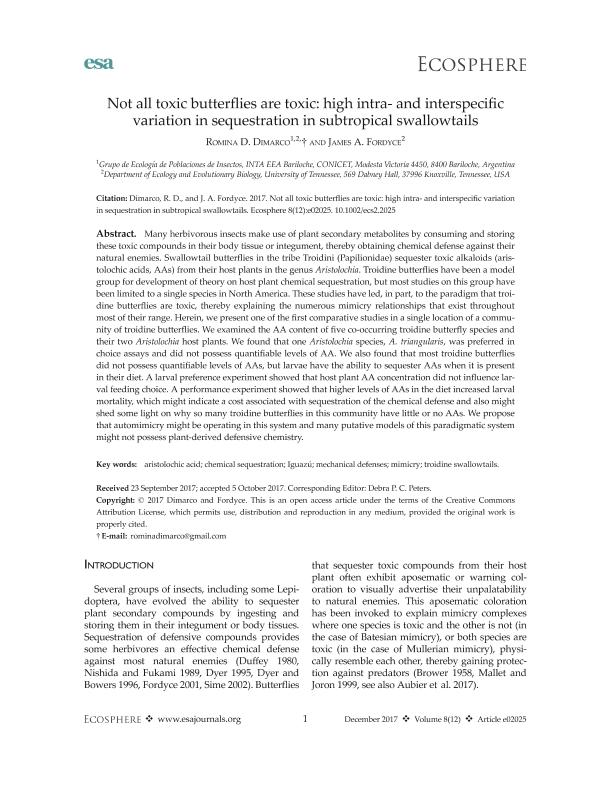Mostrar el registro sencillo del ítem
dc.contributor.author
Dimarco, Romina Daniela

dc.contributor.author
Fordyce, James A.
dc.date.available
2019-01-23T17:28:58Z
dc.date.issued
2017-12-11
dc.identifier.citation
Dimarco, Romina Daniela; Fordyce, James A.; Not all toxic butterflies are toxic: high intra- and interspecific variation in sequestration in subtropical swallowtails; Ecological Society of America; Ecosphere; 8; 12; 11-12-2017; 1-11; e02025
dc.identifier.issn
2150-8925
dc.identifier.uri
http://hdl.handle.net/11336/68441
dc.description.abstract
Many herbivorous insects make use of plant secondary metabolites by consuming and storing these toxic compounds in their body tissue or integument, thereby obtaining chemical defense against their natural enemies. Swallowtail butterflies in the tribe Troidini (Papilionidae) sequester toxic alkaloids (aristolochic acids, AAs) from their host plants in the genus Aristolochia. Troidine butterflies have been a model group for development of theory on host plant chemical sequestration, but most studies on this group have been limited to a single species in North America. These studies have led, in part, to the paradigm that troidine butterflies are toxic, thereby explaining the numerous mimicry relationships that exist throughout most of their range. Herein, we present one of the first comparative studies in a single location of a community of troidine butterflies. We examined the AA content of five co-occurring troidine butterfly species and their two Aristolochia host plants. We found that one Aristolochia species, A. triangularis, was preferred in choice assays and did not possess quantifiable levels of AA. We also found that most troidine butterflies did not possess quantifiable levels of AAs, but larvae have the ability to sequester AAs when it is present in their diet. A larval preference experiment showed that host plant AA concentration did not influence larval feeding choice. A performance experiment showed that higher levels of AAs in the diet increased larval mortality, which might indicate a cost associated with sequestration of the chemical defense and also might shed some light on why so many troidine butterflies in this community have little or no AAs. We propose that automimicry might be operating in this system and many putative models of this paradigmatic system might not possess plant-derived defensive chemistry.
dc.format
application/pdf
dc.language.iso
eng
dc.publisher
Ecological Society of America

dc.rights
info:eu-repo/semantics/openAccess
dc.rights.uri
https://creativecommons.org/licenses/by/2.5/ar/
dc.subject
Aristolochic Acid
dc.subject
Chemical Sequestration
dc.subject
Iguazu
dc.subject
Mechanical Defenses
dc.subject
Mimicry
dc.subject
Troidine Swallowtails
dc.subject.classification
Otras Ciencias Biológicas

dc.subject.classification
Ciencias Biológicas

dc.subject.classification
CIENCIAS NATURALES Y EXACTAS

dc.title
Not all toxic butterflies are toxic: high intra- and interspecific variation in sequestration in subtropical swallowtails
dc.type
info:eu-repo/semantics/article
dc.type
info:ar-repo/semantics/artículo
dc.type
info:eu-repo/semantics/publishedVersion
dc.date.updated
2019-01-14T14:19:21Z
dc.journal.volume
8
dc.journal.number
12
dc.journal.pagination
1-11; e02025
dc.journal.pais
Estados Unidos

dc.journal.ciudad
Nueva York
dc.description.fil
Fil: Dimarco, Romina Daniela. Consejo Nacional de Investigaciones Científicas y Técnicas. Centro Científico Tecnológico Conicet - Patagonia Norte; Argentina. Instituto Nacional de Tecnología Agropecuaria. Centro Regional Patagonia Norte. Estación Experimental Agropecuaria San Carlos de Bariloche; Argentina. University of Tennessee; Estados Unidos
dc.description.fil
Fil: Fordyce, James A.. University of Tennessee; Estados Unidos
dc.journal.title
Ecosphere
dc.relation.alternativeid
info:eu-repo/semantics/altIdentifier/doi/http://dx.doi.org/10.1002/ecs2.2025
dc.relation.alternativeid
info:eu-repo/semantics/altIdentifier/url/https://esajournals.onlinelibrary.wiley.com/doi/full/10.1002/ecs2.2025
Archivos asociados
